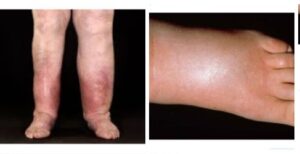
Swollen legs and feet are a common condition that can affect people of all ages. It occurs when there is an excessive accumulation of fluid in the tissues of the lower extremities, leading to swelling and discomfort. There are various causes of swollen legs and feet, ranging from lifestyle factors to underlying medical conditions. In this article, we will explore the common causes of swollen legs and feet and discuss effective ways to handle and manage this condition.
CAUSES OF SWOLLEN LEGS AND FEET:
1. Prolonged Sitting or Standing:
Remaining in one position for an extended period, such as sitting or standing for hours, can impede blood flow in the legs, leading to fluid retention and swelling according to Healthine
2. INJURY OR TRAUMA:
Injuries such as sprains, strains, or fractures can cause swelling in the affected area, including the legs and feet.
3. PREGNANCY:
During pregnancy, hormonal changes and the growing uterus can put pressure on the veins, leading to swollen legs and feet.
4. VENOUS INSUFFICIENCY:
According to Healthline, Venous insufficiency is a condition where the veins in the legs have difficulty returning blood to the heart, leading to pooling of blood and fluid retention in the legs.
5. DEEP VEIN THROMBOSIS (DVT):
DVT is a blood clot that forms in a deep vein, often in the legs. It can cause swelling, pain, and potentially life-threatening complications if the clot travels to the lungs.
6. LYMPHEDEMA:
Lymphedema is a condition where the lymphatic system fails to drain fluid properly, resulting in chronic swelling, typically in the arms or legs.
7. HEART FAILURE:
Heart failure can cause fluid to accumulate in the legs and feet due to the heart’s reduced ability to pump blood effectively.
8. KIDNEY DISEASE:
Impaired kidney function can lead to fluid retention and swelling, known as edema, in various parts of the body, including the legs and feet.
9. MEDICATIONS:
Certain medications, such as calcium channel blockers or nonsteroidal anti-inflammatory drugs (NSAIDs), can cause fluid retention and contribute to swollen legs and feet.
WAYS OF HANDLING SWOLLEN LEGS AND FEET:
1. ELEVATE THE LEGS:
Raising the legs above heart level while lying down or sitting can help reduce swelling by promoting better blood flow and fluid drainage.
2. STAY ACTIVE:
Regular physical activity, such as walking or cycling, can improve circulation and help prevent fluid buildup in the legs and feet.
3. COMPRESSION GARMENTS:
Wearing compression stockings or socks can help compress the veins and prevent fluid from accumulating in the legs.
4. AVOID PROLONGED SITTING OR STANDING:
Take breaks to move around and change positions if you are required to sit or stand for long periods.
5. MAINTAIN A HEALTHY WEIGHT:
Excess weight can put additional strain on the veins and exacerbate swelling. Maintaining a healthy weight can help alleviate the pressure on the legs.
6. LIMIT SALT INTAKE:
A high-sodium diet can contribute to fluid retention. Reducing salt intake can help manage swelling.
7. STAY HYDRATED:
Drinking plenty of water can help flush out excess fluid and prevent dehydration, which can worsen swelling.
8. SEEK MEDICAL ATTENTION:
If swollen legs and feet are persistent or accompanied by other concerning symptoms, such as chest pain or difficulty breathing, seek medical attention promptly.
Swollen legs and feet can result from various causes, including lifestyle factors and underlying medical conditions. Elevating the legs, staying active, wearing compression garments, avoiding prolonged sitting or standing, maintaining a healthy weight, limiting salt intake, staying hydrated, and seeking medical attention when necessary are effective ways to handle and manage swollen legs and feet. If you experience persistent or severe swelling or have any underlying health concerns, consult with a healthcare professional to determine the underlying cause and develop an appropriate treatment plan. By addressing the root cause and adopting lifestyle changes, you can effectively manage and alleviate swollen legs and feet, improving your overall well-being and quality of life
Healthline









